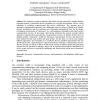Free Online Productivity Tools
i2Speak
i2Symbol
i2OCR
iTex2Img
iWeb2Print
iWeb2Shot
i2Type
iPdf2Split
iPdf2Merge
i2Bopomofo
i2Arabic
i2Style
i2Image
i2PDF
iLatex2Rtf
Sci2ools
AAMAS
2008
Springer
2008
Springer
Autonomic communication services: a new challenge for software agents
The continuous growth in ubiquitous and mobile network connectivity, together with the increasing number of networked devices populating our everyday environments, call for a deep rethinking of traditional communication and service architectures. The emerging area of autonomic communication addresses such challenging issues by trying to identify novel flexible network architectures, and by conceiving novel conceptual and practical tools for the design, development, and execution of "autonomic" (i.e., self-organizing, self-adaptive and context-aware) communication services. In this paper, after having introduced the general concepts behind autonomic communication and autonomic communication services, we analyze the key issues of defining suitable "component" models for autonomic communication services, and discuss the strict relation between such models and agent models. On this basis, we survey and compare different approaches, and eventually try to synthesize the k...
AAMAS 2008 | Autonomic Communication | Autonomic Communication Addresses | Autonomic Communication Services | Intelligent Agents |
| Added | 08 Dec 2010 |
| Updated | 08 Dec 2010 |
| Type | Journal |
| Year | 2008 |
| Where | AAMAS |
| Authors | Raffaele Quitadamo, Franco Zambonelli |
Comments (0)

